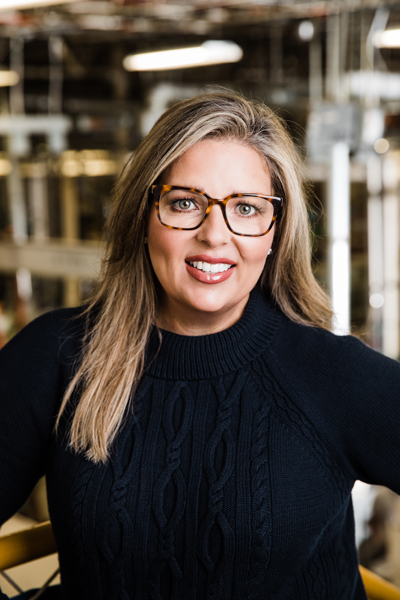BIC Graphic, formerly a division of BIC Corporation, is a leading North America-based promotional products supplier. In July 2017, BIC Graphic was acquired by HIG Capital, a global private equity and alternative assets investment firm with $28 billion of equity capital under management. Now that it’s a stand-alone company, Barbie Winterbottom, chief people officer and chief human resources officer, is spearheading the organizational transformation to ensure the iconic manufacturer of promotional products thrives for generations to come.
“Everyone loves swag, and as one of the largest suppliers of swag in the industry, we offer over 3,500 items, and even have a custom sourcing division that can create anything a client wants to promote their brand,” Winterbottom says. “For example, one of our distributors had a tire manufacturer who wanted a backpack in the shape of a tire, so we designed and created one. Our products and our ability to imprint them with any logo, phrase, and color combination has a huge impact on our customer brands. I love going to an event and seeing our products in use. Our purpose is to help build brands for our customers, and it’s really fun to see our products out there in our communities and across North America.”
Knowing the future of business and growth heavily relies on the technologies leveraged, Winterbottom spoke to Profile about her approach to utilizing technology in the HR space at BIC Graphic.

“Technologies are slick and necessary, but I want to reverse engineer it and start with our talent first,” Winterbottom says. “All too often, I have seen great sales people convince an organization to invest in XYZ technology that will transform their organization and culture, only to then realize it truly doesn’t meet the needs of that organization. We’re finding out what our people really want and need from us as a leadership team and as an employer first, and then finding and implementing technologies to help support those deliverables, but don’t overshadow them. Technology should enhance your people experience, not define it.”
Winterbottom has spent more than two decades in the world of human resources at industry giants—including Capital One, the Home Shopping Network, Amazon, and Sykes Enterprises. She also earned her master’s degree in HR management and services last year before arriving at BIC Graphic in January 2018. Here, Winterbottom discusses how she’s driving higher engagement and cross-functionality to rebuild the culture.
Which significant experiences in your background prepared you for role as CHRO?
When I look back on my career, I have been very fortunate to work with some amazing people and fantastic organizations. While I have many experiences from which to draw, I believe one of the keys to getting me to my current role is remembering how I felt in my different roles. One can look back at experiences and initiatives and want to replicate or implement them over and over, but that doesn’t always work. Each situation and each company is unique and what works in one may not work in another, but we can implement new programs and create new experiences that drive the same or similar feelings, and ultimately, that’s our goal. To create feelings of belonging, of pride and ownership, feelings of excitement and success. When we can accomplish this, we are ultimately influencing every aspect of the business.
One key tenet I live by and was reinforced during my time at Amazon is: start with the customer and work backward. Within the “People” space, starting with what we can do to help their work lives be more fulfilling, their jobs be as efficient and effective as possible, while creating meaningful connections with others is how we look at everything we do. Looking at our employees as people first and resources second, enables us to look at them holistically and understand everything we do is a touch point and an opportunity to make a positive impact.
When you walked into this new culture at BIC last January, did you have any initial goals?
My first goal was to spend time getting to know employees and leaders in order to understand their experiences. Over the past year and half leading up to and going through the transition of leaving the former parent company, BIC, to a newly formed stand-along organization under the ownership of HIG Capital, our people have been through a lot of change. We have a very tenured population, many of our people have been here for well over twenty-five years and this organization is like a member of their family.
We are a culture in transition. My team and I are working to ensure we honor our history while we build the foundation for our future and while that sounds like a great soundbite it is an extremely complex and challenging process. As we know, people don’t all move at the same pace, so striking a balance of forward progression while ensuring we don’t leave anyone behind is a conversation and focus we have daily.
So what role does technology play in the new BIC culture now?
The volume of technology now integrated into the world of human resources and people management is significant. You name it, there are at least five technology solutions for it, which is fantastic and often necessary, especially when looking at multisite, global organizations. However, the dark side of technology is that we can lose our one-on-one human interaction, so for me, the sweet spot for technology is when we can find the right balance and harmonies between the technology at the right time for the right purpose to enhance our people experience and interactions but not replace them.
And the organization in the past has been very siloed. Now we’re really looking at every possible way we can communicate and interact with people to bring everyone together.

One common struggle we share with many other organizations in the manufacturing space is that not all employees have a computer at their workstation, which inhibits their ability to receive communication real time, which can lead to frustrations and gaps in understanding. We have looked for some quick wins to help us in this particular area and have landed on implementing Workplace by Facebook as a fun, robust, and real-time way to communicate with our people. As it’s built on the same platform as the public-facing Facebook, adoption is swift and users fully integrate and master the tool quickly. We are building this framework to allow us to have informal connections and messages bi-directionally with our people, so it’s not just pushing out information, it’s also a means of gathering information in the moment. As Workplace is completely mobile intuitive, our people can access from their smartphones, tablets, or computers, and we are also providing tablets and computer stations in our break areas providing tools for those who may not have a smartphone.
Now, almost a year into your tenure as CHRO, how would you characterize where BIC is now in its cultural journey?
We’re in phase one of reinventing, redefining, and emerging as a new organization and culture. I believe culture is the result of every interaction—every communication, leadership development session, and coaching conversation. So the culture exists; it isn’t something we implement. Our job is to define the culture we want and influence behaviors to drive to that goal. Our people have told us they want a work environment that exudes fun, growth and development, transparency, robust communication, and a laser focus on the customer. The great part about this is that as a leadership team, we couldn’t have defined culture goals any better.
In regard to talent management initiatives then, are there any special considerations being inside the manufacturing industry?
Our average tenure is thirteen years, which is really high in today’s world, and the tribal knowledge and historical experiences these people have are significant and it’s important they feel a part of the change and not left behind. Part of my job is change management; introducing new concepts and ideas, but also creating programs and initiatives that serve all of our population. A phrase we use a lot here is “Honor our history, invent our future,” so everyone feels like they’re part of the initiative.
How we make this happen is part of the challenge. As mentioned before, not all employees in a manufacturing environment have access to a desktop, as it’s not part of their daily job. So finding and creating pathways for ongoing, real-time communication is the biggest challenge we face. In addition to Workplace, we are also placing communication monitors throughout the organization to ensure visibility to important information. We are using Zoom to push out information to each of the boards. By rolling out this process and serving up the information they seek in real-time, in an easy to find, easy to identify (using more graphics and less text) and integrated way, the information is consumed and digested and looking at the boards becomes part of their everyday habits. Some boards are dedicated to certain topics, like Total Rewards, daily metrics, open jobs, new product launches, and policy updates, while others may scroll varying information like welcoming new hires or in-the-moment production updates. We have the ability and flexibility to customize what we send, where we send it, how we send it, and when.
Are there any other initiatives that you’re particularly proud of so far at BIC?
We established a cross-functional team we call the “Culture Club,” which helped define core competencies and leadership behaviors, which are the foundation from which we build everything to do with the employee life cycle and experience—from attraction and selection to leadership development and performance management. This group has become an integral team of individuals who are champions for progress and the programs and initiatives to help drive us there. So far, the results are very positive, and I love seeing the ideas and passion these people have for our culture, the company, and each other.
There is a lot of tactical HR work my teams have accomplished to build the foundation needed to advance the organization as well. The work that isn’t necessarily fun or sexy, but is needed and critical to ensuring the go-forward plans are possible. I am so incredibly proud of the work they do every day and their dedication to making it happen.
How must HR leaders today evolve to keep their organization competitive?
Looking at all the tools, systems, and opportunities out there is absolutely necessary, but doing it without holding your people close can be dangerous. I would define success as great business results and great people results—in essence, the energy within the organization. The way we make people feel at work is the most important thing we do every single day.
Photo: Amy Pezzicara















